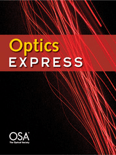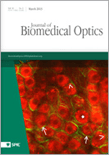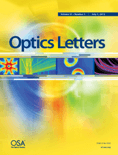
Biomedical Optics Express
Scope & Guideline
Advancing Knowledge Through Optical Technologies
Introduction
Aims and Scopes
- Optical Imaging Techniques:
The journal emphasizes the development and application of optical imaging methods, including optical coherence tomography (OCT), fluorescence microscopy, and photoacoustic imaging, for visualizing biological tissues and systems. - Biomedical Diagnostics:
Research published in the journal often explores novel diagnostic techniques using optical methods for disease detection, monitoring, and treatment response evaluation. - Innovative Optical Technologies:
The journal highlights advancements in optical technologies, such as adaptive optics, deep learning applications in imaging, and novel light delivery systems that enhance imaging capabilities. - Multimodal Imaging Approaches:
There is a consistent focus on integrating multiple imaging modalities (e.g., combining OCT with fluorescence or photoacoustic imaging) to provide comprehensive insights into biological processes. - Quantitative Analysis:
Papers frequently address quantitative methods for analyzing optical signals, including machine learning and statistical approaches to improve imaging accuracy and interpretability.
Trending and Emerging
- Machine Learning and AI in Imaging:
A significant trend is the increasing integration of machine learning and artificial intelligence techniques in optical imaging for image enhancement, segmentation, and automated analysis. - Wearable and Portable Optical Devices:
There is a growing emphasis on the development of portable and wearable optical devices for real-time health monitoring and diagnostics, making technology more accessible and practical. - Optical Biomarkers and Molecular Imaging:
Research focusing on the identification and quantification of optical biomarkers using advanced imaging techniques is gaining traction, particularly in cancer diagnostics and monitoring. - Personalized Medicine and Optical Technologies:
A notable trend is the application of optical technologies in personalized medicine, where tailored imaging approaches are developed to cater to individual patient needs and treatment responses. - Optical Clearing Techniques:
Emerging research on optical clearing methods is becoming more prominent, as these techniques facilitate deeper imaging in biological tissues, enhancing the visualization of complex structures.
Declining or Waning
- Basic Optical Physics:
There has been a noticeable decline in papers focused solely on theoretical aspects of optical physics without direct biomedical application, as the journal has shifted towards more applied research. - Traditional Imaging Techniques:
Conventional imaging methods that do not incorporate advanced technologies or multimodal approaches are appearing less frequently, as researchers gravitate towards innovative and hybrid methodologies. - Invasive Imaging Methods:
There is a trend away from invasive imaging techniques, with a growing preference for non-invasive or minimally invasive methods that align with current clinical needs and patient comfort.
Similar Journals

OPTICS EXPRESS
Where Innovation Meets Optical ResearchOPTICS EXPRESS is a premier peer-reviewed journal published by the Optica Publishing Group, specializing in the rapidly evolving fields of Atomic and Molecular Physics and Optics. With an impressive Q1 ranking in its category and positioned in the 75th percentile among leading journals in Physics and Astronomy, OPTICS EXPRESS serves as a vital platform for disseminating innovative research findings. Since its inception in 1997 and transitioning to Open Access in 1998, the journal has ensured that groundbreaking scientific contributions are accessible to a global audience, fostering collaboration and advancement in optical science. Additionally, with annual publications converging from 1997 to 2024, this journal not only tracks the latest advancements but also shapes the future landscape of optics research. Whether you are a seasoned researcher, a dedicated professional, or a passionate student, OPTICS EXPRESS offers a wealth of knowledge and a commitment to excellence in the optics community.

Current Optics and Photonics
Fostering Collaboration in the World of LightCurrent Optics and Photonics is a premier journal published by the Optical Society Korea, focusing on the dynamic and evolving fields of optics and photonics. With an ISSN of 2508-7266 and E-ISSN 2508-7274, it provides a comprehensive platform for scholarly communication, emphasizing innovations, advances in technology, and theoretical developments in atomic and molecular physics and optics. Situated in South Korea's vibrant academic landscape, this open access journal aims to bridge the gap between theoretical research and practical applications, fostering collaboration and knowledge sharing among researchers, professionals, and students alike. Although currently ranked in the Q3 category for both Atomic and Molecular Physics and Optics, with a Scopus rank of #183/224, it showcases significant contributions that enhance understanding in these critical areas. The journal encourages submission of original research articles, reviews, and technical notes, with the objective of driving forward the conversation in optics and photonics throughout its converged years from 2017 to 2024. Embrace the opportunity to contribute to this expanding field and become part of a community that is at the forefront of scientific discovery.

JOURNAL OF BIOMEDICAL OPTICS
Illuminating the Future of Biomedical ResearchJOURNAL OF BIOMEDICAL OPTICS, published by SPIE-SOC PHOTO-OPTICAL INSTRUMENTATION ENGINEERS, is a premier Open Access journal that has been at the forefront of research in the fields of optical engineering and biomedical applications since its inception in 1996. With an impressive range of studies that span atomic and molecular physics, biomedical engineering, and biomaterials, this journal is consistently recognized for its high-quality publications, evidenced by its Q1 quartile ranking in 2023 for Atomic and Molecular Physics and Optics. The journal’s impact is further validated by its Scopus rankings, placing it in the top 30% of its categories. Designed to facilitate rapid dissemination of innovative advancements in biomedical optics, this journal promotes an interdisciplinary approach, making it an essential resource for researchers, professionals, and students aiming to advance their knowledge and applications of optical technologies in medicine. The journal is committed to broadening access to groundbreaking research, having transitioned to Open Access in 2019, ensuring that the latest findings are available to a global audience.

JOURNAL OF MODERN OPTICS
Empowering Researchers in the Realm of LightJOURNAL OF MODERN OPTICS, published by Taylor & Francis Ltd, stands as a prominent bi-monthly journal contributing to the fields of Atomic and Molecular Physics and Optics. With an ISSN of 0950-0340 and an E-ISSN of 1362-3044, this journal aims to disseminate high-quality research that pushes the boundaries of optical science and its applications. Since its inception in 1981, and particularly throughout its publications from 1987 to 2024, the journal has consistently published influential studies that are essential for both academic researchers and industry professionals. Ranked in the Q3 quartile for the 2023 category of Atomic and Molecular Physics and Optics, it has a Scopus ranking of #133 out of 224, indicating its steady presence and relevance in the scientific community. Although it does not offer Open Access options, readers can access its rich repository of literature that delves into innovative optical methods, technological advancements, and theoretical frameworks. The JOURNAL OF MODERN OPTICS is an indispensable resource for those seeking to advance their knowledge and research in modern optical science.

OPTICS LETTERS
Elevating the Standards of Optical ResearchOPTICS LETTERS is a premier academic journal published by the Optica Publishing Group, dedicated to advancing the field of optics and photonics. Since its inception in 1977, it has maintained a strong reputation for publishing high-impact research, holding a distinguished Q1 category ranking in Atomic and Molecular Physics, as well as Optics, making it a vital resource for researchers and professionals alike. With an impressive Scopus rank of #55 out of 224 in its field, OPTICS LETTERS continues to shape the discourse and innovation in optical science. Authors benefit from its extensive international reach, while readers gain access to cutting-edge studies that address both theoretical and applied aspects of optics. Although the journal currently does not offer open access options, its rigorous peer-review standards ensure that every publication meets the highest academic criteria, making it an essential journal for anyone looking to stay at the forefront of optical research.

Korean Journal of Optics and Photonics
Exploring the Frontiers of Photonics ResearchKorean Journal of Optics and Photonics is a premier publication dedicated to advancing knowledge in the rapidly evolving fields of optics and photonics. Published by the esteemed Optical Society of Korea, this journal serves as a vital platform for researchers, professionals, and students seeking to disseminate their findings and innovations in areas such as optical engineering, photonics technologies, and application developments. Although the journal does not operate under an Open Access model, it is committed to high-quality peer-reviewed research that contributes significantly to both theoretical and practical advancements in the field. With an increasing focus on interdisciplinary research, the Korean Journal of Optics and Photonics is poised to play a crucial role in fostering collaboration and driving the global conversation on light science and technology. The journal's ISSN is 1225-6285 and it also carries the E-ISSN 2287-321X, ensuring its availability to a wide readership.

Chinese Optics Letters
Pioneering insights in the realm of optics.Chinese Optics Letters is a prestigious academic journal published by Chinese Laser Press, dedicated to advancing the fields of atomic and molecular physics, optics, as well as electrical and electronic engineering. Since its inception in 2003, this journal has become a significant platform for researchers and professionals to disseminate innovative findings and foster collaboration within these rapidly evolving disciplines. With a commendable Q2 ranking in leading categories including Atomic and Molecular Physics and Electronic, Optical and Magnetic Materials, it ranks favorably within the Scopus database, with notable positions in both engineering and materials science sectors. The journal is headquartered in Shanghai, China, and while additional open access options are not specified, it remains a vital resource for those committed to pushing the frontiers of optical research and applications. As we approach 2024, Chinese Optics Letters continues to play an essential role in shaping scholarly discourse and technological advancement in optics.

APL Photonics
Your Gateway to Cutting-Edge Photonics ResearchAPL Photonics is a premier open-access journal published by AIP Publishing, dedicated to the field of photonics, encompassing a broad range of research areas including atomic and molecular physics, optics, and computer networks and communications. Since its inception in 2016, the journal has positioned itself at the forefront of innovation, earning Q1 quartile rankings in both relevant categories as of 2023. With an impressive Scopus ranking that places it in the 87th and 89th percentiles for its respective fields, APL Photonics serves as a vital platform for rapid dissemination of high-impact research. Its open-access policy ensures that cutting-edge findings are accessible to researchers, professionals, and students globally, facilitating collaboration and knowledge sharing. Aimed at fostering advancements in the photonics community, this journal is essential for those looking to stay informed on the latest breakthroughs and trends in photonic technologies.

APPLIED OPTICS
Connecting Researchers to the World of OpticsApplied Optics, published by Optica Publishing Group, is a prestigious journal dedicated to the field of optics and photonics. With an ISSN of 1559-128X and an E-ISSN of 2155-3165, this journal serves as a critical platform for researchers, professionals, and students eager to disseminate innovative findings and advancements in applied optics. Established in 1962, it has maintained a significant presence in the academic community, currently holding a Q2 category ranking in various disciplines including Atomic and Molecular Physics, Electrical and Electronic Engineering, and Miscellaneous Engineering as per the 2023 metrics. The journal's reputation is underscored by its solid Scopus rankings, attesting to its influential research output. While not an open-access journal, it continues to offer vital insights and discussions on the latest research topics that are critical to the advancement of technologies in optics, ensuring accessibility to vital knowledge for those within the field.

PhotoniX
Bridging Theory and Application in PhotonicsPhotoniX is a premier open-access journal published by SPRINGERNATURE in Germany, dedicated to the fields of Atomic and Molecular Physics, Optics, and Electrical and Electronic Engineering. Launched in 2020, this journal has swiftly established itself as a key resource within the scientific community, achieving impressive rankings, notably being placed in the Q1 quartile across its categories in 2023. With its Scopus ranks highlighting its excellence—2nd in Engineering (Miscellaneous), 9th in Electrical and Electronic Engineering, and 6th in Atomic and Molecular Physics—PhotoniX serves as a critical platform for researchers to disseminate their findings. With an emphasis on broadening access to cutting-edge research, the journal offers a valuable opportunity for engagement with contemporary advancements in the fields it covers. Researchers, professionals, and students can benefit significantly from its contents, contributing to the collective knowledge in these vital areas of science and technology.